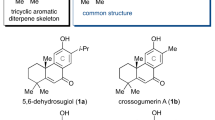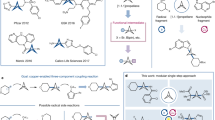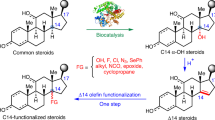Abstract
The tail-to-head terpene (THT) cyclization is a biochemical process that gives rise to many terpene natural product skeletons encountered in nature. Historically, it has been difficult to achieve THT synthetically without using an enzyme. In this protocol, a hexameric resorcin[4]arene capsule acts as an artificial enzyme mimic to carry out biomimetic THT cyclizations and related carbocationic rearrangements. The precursor molecule bears a leaving group (usually an alcohol or acetate group) and undergoes the THT reaction in the presence of the capsule catalyst and HCl as a cocatalyst. Careful control of several parameters (including water content, amount of HCl cocatalyst, temperature and solvent) is crucial to successfully carrying out the reaction. To facilitate the application of this unique capsule-catalysis methodology, we therefore developed a very detailed procedure that includes the preparation and analysis of all reaction components. In this protocol, we describe how to prepare two different terpenes: isolongifolene and presilphiperfolan-1β-ol. The two procedures differ in the water content required for efficient product formation, and thus exemplify the two common use cases of this methodology. The influence of other crucial reaction parameters and means of precisely controlling them are described. A commercially available substrate, nerol, can be used as simple test substrate to validate the reaction setup. Each synthetic procedure requires 5–7 d, including 1–5 h of hands-on time. The protocol applies to the synthesis of many complex terpene natural products that would otherwise be difficult to access in synthetically useful yields.
Key points
-
The tail-to-head terpene cyclization converts simple precursors into a wide variety of terpene structures. The enzymes used in nature are precursor specific, making it difficult to access modified terpenes.
-
A hexameric resorcin[4]arene capsule can catalyze tail-to-head terpene cyclizations for a wide variety of precursors if reaction conditions (e.g., water content and catalytic HCl concentration) are carefully optimized and controlled.
This is a preview of subscription content, access via your institution
Access options
Access Nature and 54 other Nature Portfolio journals
Get Nature+, our best-value online-access subscription
$29.99 / 30 days
cancel any time
Subscribe to this journal
Receive 12 print issues and online access
$259.00 per year
only $21.58 per issue
Buy this article
- Purchase on Springer Link
- Instant access to full article PDF
Prices may be subject to local taxes which are calculated during checkout







Similar content being viewed by others
Data availability
Relevant data for this protocol can be found in the text and Supplementary Information of this paper and/or its supporting primary research papers. Raw data for the figures have been deposited at https://zenodo.org/records/10052551.
References
Christianson, D. W. Structural and chemical biology of terpenoid cyclases. Chem. Rev. 117, 11570–11648 (2017).
Miller, D. J. & Allemann, R. K. Sesquiterpene synthases: passive catalysts or active players? Nat. Prod. Rep. 29, 60–71 (2012).
Pronin, S. V. & Shenvi, R. A. Synthesis of highly strained terpenes by non-stop tail-to-head polycyclization. Nat. Chem. 4, 915–920 (2012).
Lesburg, C. A., Zhai, G., Cane, D. E. & Christianson, D. W. Crystal structure of pentalenene synthase: mechanistic insights on terpenoid cyclization reactions in biology. Science 277, 1820 (1997).
Starks, C. M., Back, K., Chappell, J. & Noel, J. P. Structural basis for cyclic terpene biosynthesis by tobacco 5-epi-aristolochene synthase. Science 277, 1815 (1997).
Guerra-Bubb, J., Croteau, R. & Williams, R. M. The early stages of taxol biosynthesis: an interim report on the synthesis and identification of early pathway metabolites. Nat. Prod. Rep. 29, 683–696 (2012).
Paddon, C. J. et al. High-level semi-synthetic production of the potent antimalarial artemisinin. Nature 496, 528–532 (2013).
Gutsche, C. D., Maycock, J. R. & Chang, C. T. Acid-catalyzed cyclization of farnesol and nerolidol. Tetrahedron 24, 859–876 (1968).
Ohta, Y. & Hirose, Y. Electrophile-induced cyclization of farnesol. Chem. Lett. 1, 263–266 (1972).
Andersen, N. H. & Syrdal, D. D. Chemical simulation of the biogenesis of cedrene. Tetrahedron Lett. 13, 2455–2458 (1972).
Kobayashi, S., Tsutsui, M. & Mukaiyama, T. Biogenetic-like cyclization of farnesol and nerolidol to bisabolene by the use of 2-fluorobenzothiazolium salt. Chem. Lett. 6, 1169–1172 (1977).
Croteau, R. Biosynthesis and catabolism of monoterpenoids. Chem. Rev. 87, 929–954 (1987).
Polovinka, M. P. et al. Cyclization and rearrangements of farnesol and nerolidol stereoisomers in superacids. J. Org. Chem. 59, 1509–1517 (1994).
Zhang, Q. & Tiefenbacher, K. Terpene cyclization catalysed inside a self-assembled cavity. Nat. Chem. 7, 197–202 (2015).
Zhang, Q., Catti, L., Pleiss, J. & Tiefenbacher, K. Terpene cyclizations inside a supramolecular catalyst: leaving-group-controlled product selectivity and mechanistic studies. J. Am. Chem. Soc. 139, 11482–11492 (2017).
Zhang, Q., Rinkel, J., Goldfuss, B., Dickschat, J. S. & Tiefenbacher, K. Sesquiterpene cyclizations catalysed inside the resorcinarene capsule and application in the short synthesis of isolongifolene and isolongifolenone. Nat. Catal. 1, 609–615 (2018).
Zhang, Q. & Tiefenbacher, K. Sesquiterpene cyclizations inside the hexameric resorcinarene capsule: total synthesis of δ-selinene and mechanistic studies. Angew. Chem. Int. Ed. 58, 12688–12695 (2019).
Syntrivanis, L.-D. et al. Four-step access to the sesquiterpene natural product presilphiperfolan-1β-ol and unnatural derivatives via supramolecular catalysis. J. Am. Chem. Soc. 142, 5894–5900 (2020).
Némethová, I., Schmid, D. & Tiefenbacher, K. Supramolecular capsule catalysis enables the exploration of terpenoid chemical space untapped by nature. Angew. Chem. Int. Ed. 62, e202218625 (2023).
Kirby, A. J. Enzyme mechanisms, models, and mimics. Angew. Chem. Int. Ed. 35, 706–724 (1996).
Breslow, R. & Dong, S. D. Biomimetic reactions catalyzed by cyclodextrins and their derivatives. Chem. Rev. 98, 1997–2012 (1998).
Motherwell, W. B., Bingham, M. J. & Six, Y. Recent progress in the design and synthesis of artificial enzymes. Tetrahedron 57, 4663–4686 (2001).
Koblenz, T. S., Wassenaar, J. & Reek, J. N. H. Reactivity within a confined self-assembled nanospace. Chem. Soc. Rev. 37, 247–262 (2008).
Yoshizawa, M., Klosterman, J. K. & Fujita, M. Functional molecular flasks: new properties and reactions within discrete, self-assembled hosts. Angew. Chem. Int. Ed. 48, 3418–3438 (2009).
Wiester, M. J., Ulmann, P. A. & Mirkin, C. A. Enzyme mimics based upon supramolecular coordination chemistry. Angew. Chem. Int. Ed. 50, 114–137 (2011).
Ajami, D. & Rebek, J. More chemistry in small spaces. Acc. Chem. Res. 46, 990–999 (2013).
Raynal, M., Ballester, P., Vidal-Ferran, A. & van Leeuwen, P. W. N. M. Supramolecular catalysis. Part 2: artificial enzyme mimics. Chem. Soc. Rev. 43, 1734–1787 (2014).
Brown, C. J., Toste, F. D., Bergman, R. G. & Raymond, K. N. Supramolecular catalysis in metal–ligand cluster hosts. Chem. Rev. 115, 3012–3035 (2015).
Leenders, S. H. A. M., Gramage-Doria, R., de Bruin, B. & Reek, J. N. H. Transition metal catalysis in confined spaces. Chem. Soc. Rev. 44, 433–448 (2015).
Zarra, S., Wood, D. M., Roberts, D. A. & Nitschke, J. R. Molecular containers in complex chemical systems. Chem. Soc. Rev. 44, 419–432 (2015).
Borsato, G. & Scarso, A. in Organic Nanoreactors (ed Samahe Sadjadi) 203–234 (Academic Press, 2016).
Zhang, Q., Catti, L. & Tiefenbacher, K. Catalysis inside the hexameric resorcinarene capsule. Acc. Chem. Res. 51, 2107–2114 (2018).
Mouarrawis, V., Plessius, R., van der Vlugt, J. I. & Reek, J. N. H. Confinement effects in catalysis using well-defined materials and cages. Front. Chem. 6, 623 (2018).
Ward, M. D., Hunter, C. A. & Williams, N. H. Coordination cages based on bis(pyrazolylpyridine) ligands: structures, dynamic behavior, guest binding, and catalysis. Acc. Chem. Res. 51, 2073–2082 (2018).
Hong, C. M., Bergman, R. G., Raymond, K. N. & Toste, F. D. Self-assembled tetrahedral hosts as supramolecular catalysts. Acc. Chem. Res. 51, 2447–2455 (2018).
Jongkind, L. J., Caumes, X., Hartendorp, A. P. T. & Reek, J. N. H. Ligand template strategies for catalyst encapsulation. Acc. Chem. Res. 51, 2115–2128 (2018).
Fang, Y. et al. Catalytic reactions within the cavity of coordination cages. Chem. Soc. Rev. 48, 4707–4730 (2019).
Gaeta, C. et al. The hexameric resorcinarene capsule at work: supramolecular catalysis in confined spaces. Chem. Eur. J. 25, 4899–4913 (2019).
Percástegui, E. G., Ronson, T. K. & Nitschke, J. R. Design and applications of water-soluble coordination cages. Chem. Rev. 120, 13480–13544 (2020).
Némethová, I., Syntrivanis, L.-D. & Tiefenbacher, K. Molecular capsule catalysis: ready to address current challenges in synthetic organic chemistry? Chim. (Aarau) 74, 561–568 (2020).
Morimoto, M. et al. Advances in supramolecular host-mediated reactivity. Nat. Catal. 3, 969–984 (2020).
Wang, K., Jordan, J. H., Hu, X.-Y. & Wang, L. Supramolecular strategies for controlling reactivity within confined nanospaces. Angew. Chem. Int. Ed. 59, 13712–13721 (2020).
Grommet, A. B., Feller, M. & Klajn, R. Chemical reactivity under nanoconfinement. Nat. Nanotechnol. 15, 256–271 (2020).
Hooley, R. J. No, not that way, the other way: creating active sites in self-assembled host molecules. Synlett 31, 1448–1463 (2020).
Mitschke, B., Turberg, M. & List, B. Confinement as a unifying element in selective catalysis. Chem 6, 2515–2532 (2020).
Yu, Y., Yang, J.-M. & Rebek, J. Molecules in confined spaces: reactivities and possibilities in cavitands. Chem 6, 1265–1274 (2020).
Ashbaugh, H. S., Gibb, B. C. & Suating, P. Cavitand complexes in aqueous solution: collaborative experimental and computational studies of the wetting, assembly, and function of nanoscopic bowls in water. J. Phys. Chem. B 125, 3253–3268 (2021).
Takezawa, H. & Fujita, M. Molecular confinement effects by self-assembled coordination cages. Bull. Chem. Soc. Jpn 94, 2351–2369 (2021).
Gaeta, C. et al. Supramolecular catalysis with self-assembled capsules and cages: what happens in confined spaces. ChemCatChem 13, 1638–1658 (2021).
MacGillivray, L. R. & Atwood, J. L. A chiral spherical molecular assembly held together by 60 hydrogen bonds. Nature 389, 469–472 (1997).
Avram, L. & Cohen, Y. Spontaneous formation of hexameric resorcinarene capsule in chloroform solution as detected by diffusion NMR. J. Am. Chem. Soc. 124, 15148–15149 (2002).
Avram, L., Cohen, Y. & Rebek, J. Jr Recent advances in hydrogen-bonded hexameric encapsulation complexes. Chem. Commun. 47, 5368–5375 (2011).
Yamanaka, M., Shivanyuk, A. & Rebek, J. Kinetics and thermodynamics of hexameric capsule formation. J. Am. Chem. Soc. 126, 2939–2943 (2004).
Pahima, E., Zhang, Q., Tiefenbacher, K. & Major, D. T. Discovering monoterpene catalysis inside nanocapsules with multiscale modeling and experiments. J. Am. Chem. Soc. 141, 6234–6246 (2019).
Merget, S., Catti, L., Piccini, G. & Tiefenbacher, K. Requirements for terpene cyclizations inside the supramolecular resorcinarene capsule: bound water and its protonation determine the catalytic activity. J. Am. Chem. Soc. 142, 4400–4410 (2020).
Sokolova, D., Piccini, G. & Tiefenbacher, K. Enantioselective tail-to-head terpene cyclizations by optically active hexameric resorcin[4]arene capsule derivatives. Angew. Chem. Int. Ed. 61, e202203384 (2022).
Sobti, R. R. & Dev, S. Synthesis of (±)-isolongifolene. Tetrahedron Lett. 8, 2893–2895 (1967).
Sobti, R. R. & Dev, S. Studies in sesquiterpenes—XLIII: isolongifolene (part 4): synthesis. Tetrahedron 26, 649–655 (1970).
Hong, A. Y. & Stoltz, B. M. Enantioselective total synthesis of the reported structures of (-)-9-epi-presilphiperfolan-1-ol and (-)-presilphiperfolan-1-ol: structural confirmation and reassignment and biosynthetic insights. Angew. Chem. Int. Ed. 51, 9674–9678 (2012).
Catti, L. & Tiefenbacher, K. Intramolecular hydroalkoxylation catalyzed inside a self-assembled cavity of an enzyme-like host structure. Chem. Commun. 51, 892–894 (2015).
Köster, J. M. & Tiefenbacher, K. Elucidating the importance of hydrochloric acid as a cocatalyst for resorcinarene-capsule-catalyzed reactions. ChemCatChem 10, 2941–2944 (2018).
Acknowledgements
This publication was created as part of National Centre of Competence in Research (NCCR) Catalysis, funded by the Swiss National Science Foundation. L.-D.S. thanks the University of Basel for a Novartis Universität Basel Excellence Scholarship for Life Sciences.
Author information
Authors and Affiliations
Contributions
I.C. optimized Protocol 2 and wrote a first version of this part. L.-D.S. optimized Protocol 3 and wrote a first version of this part and the introduction. K.T. supervised the project and helped write the protocols.
Corresponding author
Ethics declarations
Competing interests
The authors declare no competing interests.
Peer review
Peer review information
Nature Protocols thanks Carmine Gaeta and the other, anonymous, reviewer(s) for their contribution to the peer review of this work.
Additional information
Publisher’s note Springer Nature remains neutral with regard to jurisdictional claims in published maps and institutional affiliations.
Related links
Key references using this protocol
Zhang, Q. & Tiefenbacher, K. Nat. Chem. 7, 197–202 (2015): https://doi.org/10.1038/nchem.2181
Zhang, Q. et al. Nat. Catal. 1, 609–615 (2018): https://doi.org/10.1038/s41929-018-0115-4
Syntrivanis, L.-D. et al. J. Am. Chem. Soc. 142, 5894–5900 (2020): https://doi.org/10.1021/jacs.0c01464
Key data used in this protocol
Zhang, Q. et al. Nat. Catal. 1, 609–615 (2018): https://doi.org/10.1038/s41929-018-0115-4
Syntrivanis, L.-D. et al. J. Am. Chem. Soc. 142, 5894–5900 (2020): https://doi.org/10.1021/jacs.0c01464
Extended data
Extended Data Fig. 1 HCl stock solution preparation.
Setup for the preparation of the HCl stock solution in chloroform or benzene.
Extended Data Fig. 2 HCl stock solution titration.
HCl solution titration coloration (a) before endpoint and (b) at the endpoint.
Extended Data Fig. 3 Resorcin[4]arene synthesis.
Resorcin[4]arene synthesis photos (see Procedure for corresponding letters).
Extended Data Fig. 4 Photo of the resorcin[4]arene stock solution prepared in Steps 9–17 of Procedure 2.
Resorcin[4]arene stock solution.
Extended Data Fig. 5 Dissolution of resorcin[4]arene in water-saturated chloroform.
Resorcin[4]arene catalyst in water-saturated chloroform (Procedure 3, Step 5), before (a) and after (b) complete dissolution.
Extended Data Fig. 6 Reaction setup.
Reaction setup (a) screening scale, (b) preparative scale synthesis of isolongifolene (Procedure 2) and (c) preparative scale synthesis of presilphipefolan-1β-ol (Procedure 3).
Supplementary information
Supplementary Information
Supplementary Figs. 1–10 and derivation of the equations.
Rights and permissions
Springer Nature or its licensor (e.g. a society or other partner) holds exclusive rights to this article under a publishing agreement with the author(s) or other rightsholder(s); author self-archiving of the accepted manuscript version of this article is solely governed by the terms of such publishing agreement and applicable law.
About this article
Cite this article
Cornu, I., Syntrivanis, LD. & Tiefenbacher, K. Biomimetic tail-to-head terpene cyclizations using the resorcin[4]arene capsule catalyst. Nat Protoc 19, 313–339 (2024). https://doi.org/10.1038/s41596-023-00919-3
Received:
Accepted:
Published:
Issue Date:
DOI: https://doi.org/10.1038/s41596-023-00919-3
Comments
By submitting a comment you agree to abide by our Terms and Community Guidelines. If you find something abusive or that does not comply with our terms or guidelines please flag it as inappropriate.



